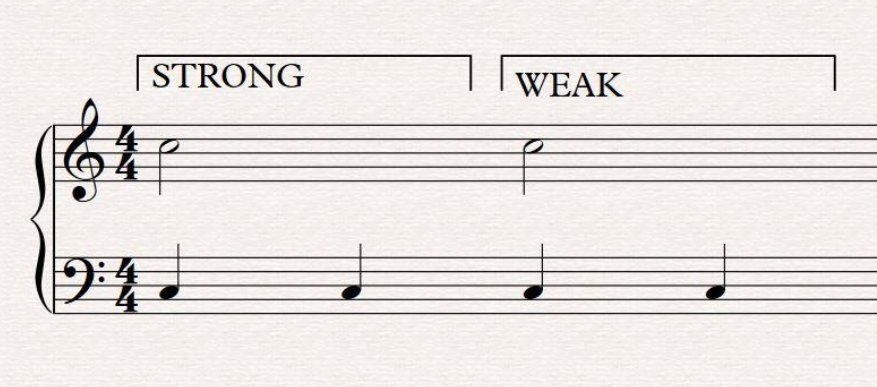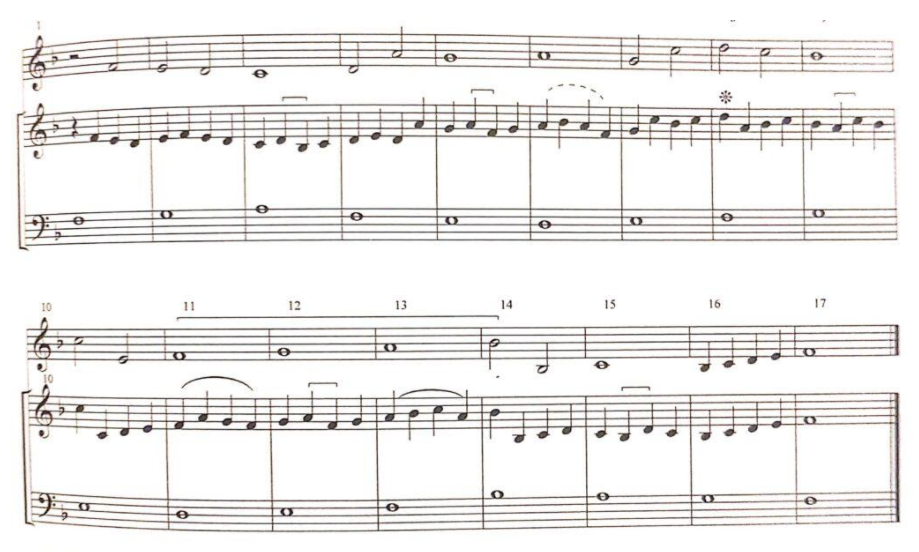Uncategorized
Counterpoint – Third Species
https://www.youtube.com/watch?v=GebyECuk35s&feature=emb_logo
Third Species
INTRODUCTION
In this species of Counterpoint, we will cover the relation between four notes against one. Although we could use any note values, we will determine the use of four crotchets or quarter notes against a semibreve or whole note.
The rhythmic organisation in this species has now one main division: the first two crotchets of the bar are the strongest while the third and fourth crotchets are placed on the weakest part of the bar, providing a binary division of the bar STRONG-WEAK into two minims or half notes. Into this main division, there is a subdivision which consists in giving the first and the third crotchets of the bar (the first of each sub-group) a stronger presence within the beat:

As in the first and second species, the first note must be a consonance and the second species rules apply. We will start on the second crotchet of the bar with either an octave, unison or fifth if the Cantus Firmus (CF) is located on the lower voice, and an octave or unison if the CF is located on the upper voice. The final note as in the previous species we will be note-against-note, in this case, semibreves.
We will apply two types of non-consonant intervals:
1. The passing note
Already presented on the second species which works the voice progression as it allows to move in a continuous melodic line from one note to another providing directional motion, and
2. Neighbouring note
That prolongs the value of a note through an embellishment. This resource will allow us to work the concept of PROLONGATION which was coined by Feliz Salzer.
PROLONGATION
In the third species, we encounter this powerful concept that will serve us not only in this species but in composition in general as we will see that the neighbouring note has a vital function: “it delays or retard the ultimate melodic progression without halting local melodic activity” (Feliz Salzer – Counterpoint in Composition – p. 58).
The prolongation implies a certain “standstill” in the voice progression. It is defined by a sound that comes from a harmonic consonance, moves by step upward or downward from that note and comes back the same way, by step to the same note.
It can be consonant or dissonant against the CF. When it is consonant against the CF, it is called “real sound”. The latter is vital for the voice leading as it is considered a pillar on which the melodic line stands.
The neighbouring note can serve to change the direction of the musical discourse. From it, the direction of the melodic progression can change through this resource.
Examples

Example 3-7. Page 58 (The study of Counterpoint and voice leading. Feliz Salzer)
Consonant Neighbouring Note
The alternation of two adjacent consonances, for example, the perfect fifth and the sixth can produce a consonant neighbouring note, as in the case of the second species with consonant passing notes. This particular case, as per its vertical stability, can happen freely along with the counterpoint.
Double Neighbouring Note
It is the combination between upper and lower neighbour notes around a real sound.
The double neighbouring note amplifies the concept of prolongation in the melody. We can see this happen whenever various sounds make a melodic turn that starts and returns from and to a real sound; this phenomenon is called “embellishment”.
For the latter to happen, we should use a combination between passing notes, neighbouring and double neighbouring notes.

“Contrapunto y polifonia” Page 80 (Eduardo Checchi)
As a rule, the idiom sounds smoothest if the upper neighbour precedes the lower. In this configuration, the higher, more obtrusive sound comes on the weaker beat. It is best if one of the neighbours is a semitone from the principal tone. If both lie one tone away, the melodic connection may become somewhat weakened.

“Counterpoint in composition and the study of voice leading” page 61 Feliz Salzer

Chopin, Etude, Op. 10, No. 4
RULES & EXAMPLES
UNISON
As in the second species, the unison should be at the beginning or the end of the Counterpoint. In the case of the third species, unisons can also occur throughout but never on the strong beat (first beat of the bar). It can only be approached and continue in oblique motion.
FIFTHS, OCTAVES AND UNISONS
Parallel fifths, octaves and unisons are forbidden. The correct distance between them must be three notes. Some exception may apply if the melodic line demands it, for example, in between the second beat and the first beat of the following bar, but always as exceptions, not as a rule.
MELODIC LEAPS
This species offers a quicker rate of motion in the Counterpoint line, so some guidelines are needed.
Any disruption on the melodic line is cause by disjunct movement, such as leaps of fifths or greater; therefore, they should be employed sparingly. Two consecutive leaps or skip and leap should be avoided, that’s to say, any interval that comprises a seventh between two consecutive notes.
Melodic leaps that continue the direction of immediately preceding stepwise motion must be treated as follows: leaps should coincide with a change in direction. It is possible to leap in the same direction as a good effect after two or three conjunct notes. After a group of more than three stepwise tones, however, a leap in the same direction will cause an unbalanced effect. The latter can be worsened if it is done by a metrical position from the fourth to the first beats.

Example 3-34. Page 66 (The study of Counterpoint and voice leading. Feliz Salzer)
CLIMAX
The highest melodic point or climax should always be consonant, regardless of the beat, it is located. Therefore, a neighbouring consonant note CAN be a pivotal point in the Counterpoint.
It is paramount to achieve a balanced and organic effect to organise the total melodic line ahead and set a plan accordingly. For better results, it is advisable to have one or two subsidiary climaxes before or after the main one. Otherwise, the risk is to obtain a shapeless or undirected line.
Embellishments applied to the climax is also a good device. It is considered part of the same statement as a prolongation of the highest note.
ENDINGS
The endings work as the second or first species. The Counterpoint must finish with the leading note on the fourth beat against the supertonic (semibreve) of the CF. The last bar will be in octaves or unison on the tonic degree.
If the music is in minor mode, the melodic ascending scale is needed in the Counterpoint voice.
EXAMPLES
In the following example, we can see double neighbouring notes in brackets, embellishment within slurs and dotted slurs represent prolongations.
The phenomenon called “Reduction” is located on the upper staff and denotes the voice leading by eliminating all the resources aforementioned:

“Contrapunto y Polifonia” – Page 83 (Eduardo Checchi)
MINOR MODE

Example 3-41. Page 68 (The study of Counterpoint and voice leading. Feliz Salzer)

